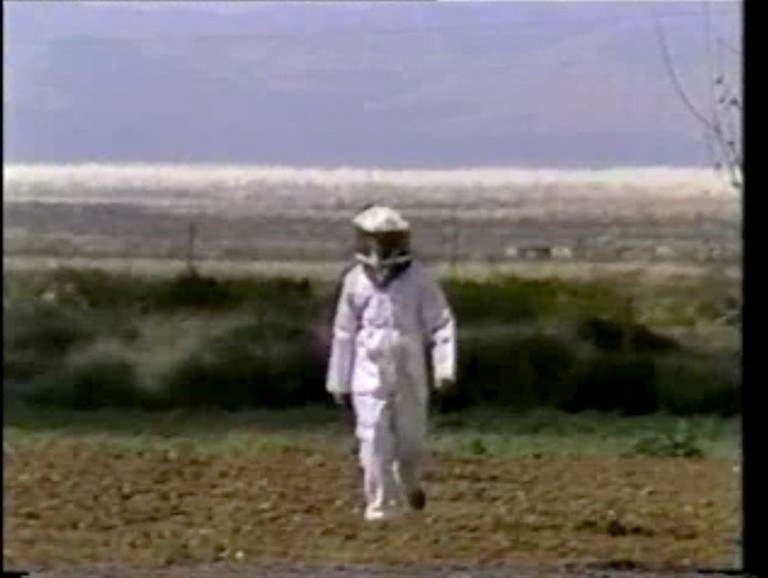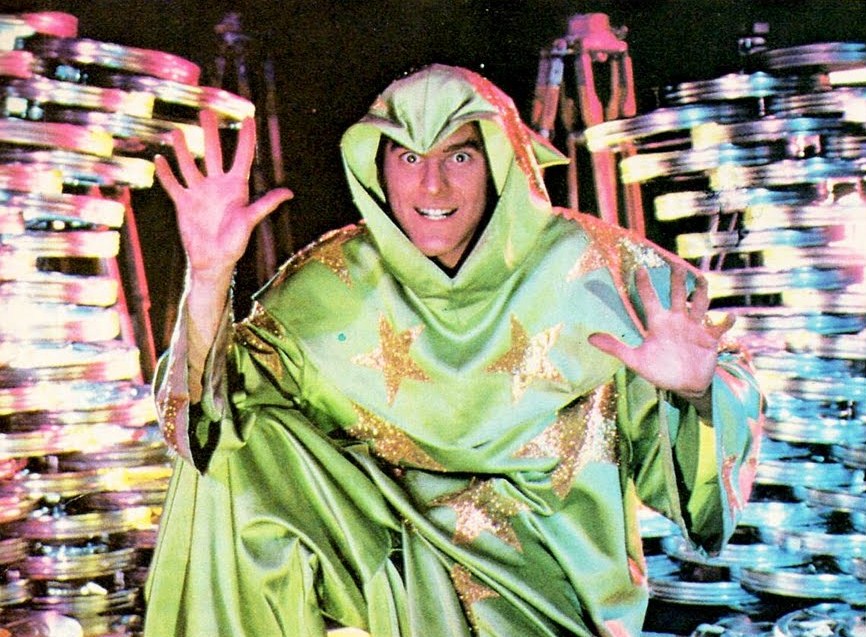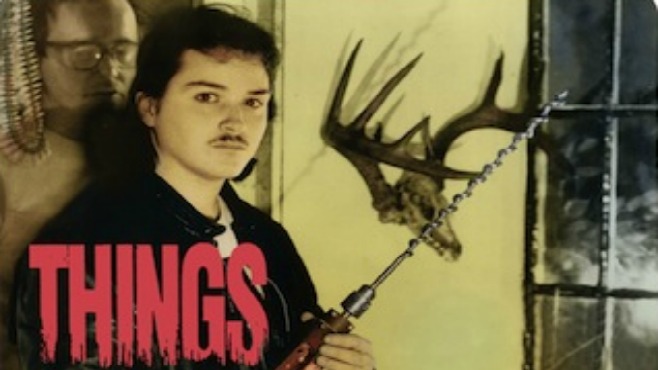5. Wax or the Discovery of Television among the Bees

All art, if looked at through the specific lens, can be seen as strange. Some artists go beyond the pale and create works that either shock and disturb or confuse and mentally antagonise. Sometimes, it works, like the films of David Lynch or Terry Gilliam, sometimes it doesn’t, like for Tarsem Singh or Gaspar Noé. But sometimes, it takes a real visionary of either madness or genius to turn out the most surreal, singular, mind-bender of an art film imaginable.
Enter David Blair and his cyberpunk magnum opus Wax or the Discovery of Television among the Bees. In 1992, the film had already made waves and generated a small cult following, and in the following year of 1993, the film was shown over the internet, becoming the first film to do so. It has since been formatted into hypertext and become free for streaming on the internet.
Wax is a strange film, more so than most. On its surface, it looks to be nothing more than an exercise in esoteric paranormal concepts demonstrated through rudimentary manipulations of camcorder footage of a man walking around in a beekeeper suit with occasional cuts to psychedelic images of bees and CGI hexagons and mysterious languages.
And for the most part, that’s exactly what Wax is. No getting around that. Its protagonist, Jacob Maker, narrates the entire film and delves into his family history, regarding the paranormal photographical experiments involving his grandfather James ‘Hive’ Maker (played by author William S. Burroughs in a miniscule cameo), and his eventual run-in with his grandfather’s Mesopotamian bees.
The bees, themselves an unusual breed, drill a hole into Jacob’s head and installs a crystal which allows Jacob to see incredible and ancient things, resulting in the bees being able to communicate with their hapless keeper. It’s a weird, haphazard, and hallucinatory little oddity that tries to tell an unorthodox story through unorthodox methods.
The images bend and warp by their own accord, Jacob Maker’s nasally voice recalls the increasingly discombobulated story while namedropping a great many obscure and esoteric concepts, primitive CGI intercuts with aged black-and-white photos of ghosts and beekeeping, and the odd VHS quality of the film overall oozes a nostalgic late night television vibe.
It’s a film that tries to generate an intricate mythology while telling a surreal story of the land of the dead and thought machines, but not quite succeeding nor completely failing. It’s psychedelic and striking, muddled and pretentious.
As confusing as it is confused. Wax or the Discovery of Television among the Bees is proof that avant-garde filmmaking knows no singular form nor formula. Even if it doesn’t always work.
6. The Wizard of Speed and Time

Practical effects, even in the face of the far more dominant CGI effects, will always have a home in the hearts of cinephiles the world over. Regardless of what Hollywood churns out, that far-off age of men in monster suits, prosthetic limbs, and gallons of syrupy blood will always be looked back on with much nostalgia and appreciation.
Films that showcase such effects with a genuine love for them surely have a built-in audience, and some filmmakers will go to great lengths to either pay tribute to or artistically utilize such methods and techniques for the sake of their love of film. One of the most complex methods of achieving a practical effect is through the tedious and elaborate process of stop-motion animation.
This is where former Disney animator Mike Jittlov comes into the picture, an incredible talent of animation who made a now-legendary 1979 short film called The Wizard of Speed and Time for a television special about cinematic special effects.
Wild, vibrant, and fantastical, this 3- minute thrill ride can amaze even the most ardent practical effects connoisseurs, filled with wild time-lapses and surreal pixilation sequences. And after a decade of being shown at sci-fi conventions, Jittlov released a full-length film based around both the magic of special effects and the making of his short film.
The 1989 version of The Wizard of Speed and Time is a low-budget masterclass in quirky independent filmmaking. While it can easily be dismissed as a self-indulgent pet project by an animator who was so proud of his one moment of cult recognition that he decided to base an entire feature-length film on its creation.
And yet, despite all that, Jittlov’s weird little movie-about-movies possesses a charm and genuine appreciation for hand-made special effect. It has a zany pace and vibe throughout it, heightened by Jittlov’s oddball nature. Don’t call it charisma, but there is something undoubtedly magnetic about his love for the special effect process and desire to just make movies, putting him at odds with the studio executives that have hired him for a television special on special effects.
This premise serves as the catalyst for Jittlov’s misadventures throughout Los Angeles, trying to finish the film with his nonexistent film crew. Throw in lots of jabs at Hollywood, almost whimsical in-camera effects, squid pizzas, a lot of dubbing, and some of the most fantastic special effects and stop motion sequences ever committed to film, and you’ve got a real fun time that cinephiles and practical effects nerds can get behind.
7. Things

The worst film ever made. A claim that gets thrown around so much that it loses impact with each utterance. Many have laid claim to have found it, that golden goose of pure cinematic trash. But Things really is that film. This isn’t an internet age, shot-on-camcorder failure, this is the greatest cinematic train-wreck ever made. The result of two hard-core horror fans, Andrew Jordan and Barry J. Gillis, and their $35,000 budget, Things is a grand crime against filmmaking.
A grimy, 8mm nightmare, Things tells the story of Doug, his brother Don, the supposedly evil Dr. Lucas, and the gruesome brood of ‘things’ that explode from Doug’s wife’s womb. But this plot only takes up a staggering 10-15 minutes of the 83 minute runtime.
From drinking beer and making cheese sandwiches, to porn star Amber Lynn (in her debut “mainstream” film role) reporting on completely irrelevant news stories at random intervals during the film, Things goes so far beyond what a bad film has come to be known and has taken on a whole new level of shit cinema. Red Letter Media has suggested that it’s one of the worst films ever, and many cult film critics have heralded it for all the wrong reasons.
Its incompetent production design, nonsensical dialogue and narrative, gratingly awful sound design/mixing, lower-than-amateur acting, poorly made horror references, and just overall incoherency makes it one of the most infuriating, confounding, antagonistic, and perplexing viewing experiences anyone could have.
What makes Things stand out among other films is that while other so-bad-they’re-good films look like they were made for some kind of release, while Things looks like a home movie that was put to VHS and released by sheer mistake, like some act of incompetence on the distributors. And yet, it holds up to this day, winning over new fans who dare to dig deep into the world of cult horror films. Those with the stomach and patience to endure Things will come out the other side either enraged or enamoured.
Things shouldn’t exist. But it does. Make of that what you will.
Author Bio: Mason Chennells is an aspiring writer and life-long cinephile living in Alberta, Canada. He usually can be found hiding out in a local theater or library when he’s not writing. He’s also an amateur musician, artist, and novice Esperantist.